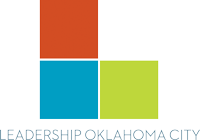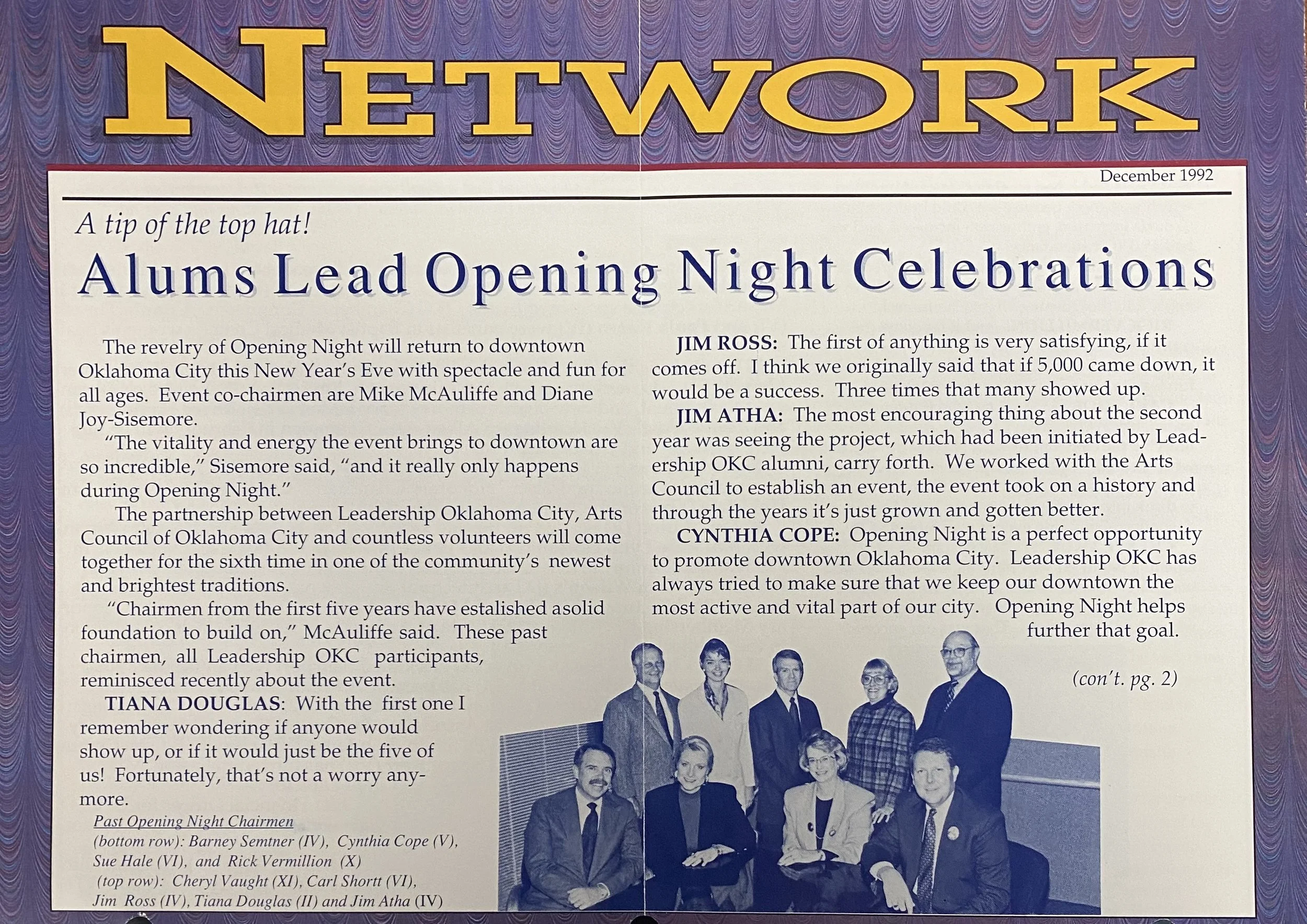Opening Night
What does the East coast city of Boston have in common with Oklahoma City? Most people would say, “not much!”
Boston has a pre-revolutionary war history and was the scene of the famous colonists’ rebellion against the King’s tax on tea. Oklahoma City didn’t even exist until more than 130 years later. It wasn’t really famous until oil was discovered on the Capitol grounds.
And if you want to talk about having a party for 50,000 of your closest friends, why would you seek advice form Bostonians who don’t event put an “r” in the word party? (They really do pronounce it “potty”).
But in 1986, Leadership Oklahoma City grads Jackie Jones (Class I), Tiana Douglas (Class II), Jim Ross (Class IV) and other folks from the Arts Council of Oklahoma City visited Boston. Boston had been throwing an awesome party once a year and everyone in Boston was invited to come.
The Oklahoma City contingent came home with the firm resolve that this could be done in Oklahoma City, especially if the Arts Council joined forces with Leadership Oklahoma City.
They decided to start small, with a few entertainment venues and a little food and a few dozen volunteers. They hoped, that with a little publicity, they could attract at least 3,000 people to their first downtown party in 1987.
But these best laid plans, as so happens, went awry. The party, held on one of the coldest nights of the year and preceded by an ice storm, brought not 3,000 people… but 10,000 enthusiastic participants.
I’m sure by now you have guessed that Opening Night, our successful New Year’s Eve event, was off to a running start. It now attracts between 25,000 and 50,000 participants each year. The event relies heavily on the support of corporate sponsors to raise funds and tireless volunteers who spend their New Year’s Eves providing a safe environment and family fun for all ages.
Many of the Opening Night co-chairs have been Leadership Oklahoma City grads as are many of those who volunteer year after year for this wonderful event.
Oklahoma School of Science and Math
In the 1980s, state and city leaders had been thinking about how to move Oklahoma City and Oklahoma into a position of excellence in the sciences.
Actually, it was all about brains. Topping the to-do-list was giving young brains specialized training and then stopping the “brain drain” from Oklahoma by interesting them in Oklahoma college and universities.
And as the idea crystallized, some Leadership Oklahoma City participants in Class V put their brains to work to get this specialized school located int eh metro area. They included chairman Ann Ackerman and members Ron Bogle, Steve Lynn, Mark Robertson, Mary Delle Stelzer, Vicki Miles-LaGrange, and Hershel Lamirand who formed a committee to see what they could do.
For over a year they worked with the legislatively appointed selection committee, fighting off bids from Stillwater, Edmond and Norman. In the final vote, the committee was deadlocked between OKC and Stillwater with one vote outstanding, that of Senator Penny Williams from Tulsa, who voted for the Oklahoma City location.
As a result, in the first 10 classes, 596 students have graduated from the Oklahoma School of Science and Math. OSSM, as it is fondly called, has produced 156 National Merit Scholars. Two students have been named National Presidential Scholars. The Oklahoma Medical Research Foundation has offered Sir Alexander Fleming Scholarships to 12 OSSM students. Nine students have graduated with appointments to the United States Naval Academy, seven to the United States Air Force Academy and one to the United States Military Academy at West Point. And hundreds have received other prestigious awards and scholarships. Best of all, 66 percent attend Oklahoma colleges and universities.
Over 10,000 Oklahoma teachers have taken advantage of workshops and seminars provided by the faculty, and the school has been recognized by Redbook Magazine as one of “America’s Best Schools.” In addition, in the eleven-year history of the school, students have come from 76 of Oklahoma’s 77 counties.
What an awesome achievement for this city and this state!
Also, in the area of health and science, graduates of Leadership Oklahoma City determined that there was a need for an endowed chair at the University of Oklahoma College of Medicine in Molecular Biology.
The chair was originally funded at $750,000. Today, it is over $2 million and growing. The purpose was to help Oklahoma catch up in an area that is the fastest growing scientific arena. Leading the charge way Lynn Carrozza and a group of fellow LOKC Class V members, including Jack Mildren and David Rainbolt. To raise that much money in one year was challenging but they received much appreciated assistance from the former president of the Presbyterian Health Foundation, Ed Miller. As a result, the chair was named for Miller.
LOKC grads have participated in many other ways in the health community, both professionally and as volunteers. But the above are two outstanding examples of the way our graduates have provided ongoing support for our community and our state into the 21st Century.
Title
Leadership Oklahoma City’s direct involvement in community improvement defies simple categorization. Over the past twenty years, LOKC has partnered with other organizations, created its own projects, and provided additional volunteer manpower to existing projects. The only common thread among them is that there was a thoughtful assessment of the best way for Leadership Oklahoma City to involve itself in a particular initiative.
In 1993, Leadership Oklahoma City, the Oklahoma City Community Foundation, and the Association of Central Oklahoma Governments partnered to produce a community strategic plan. Central Oklahoma 2020 was peopled by “stakeholders,” corporate executives, civic volunteers, educators, retirees, elected officials, small business owners, immigrants and lifelong Oklahomans. These visionaries met for a year, and when they finished, twelve initiatives had been identified. These initiatives were strategic steps to a better central Oklahoma and included ideas that matured into a one-stop 24-hour juvenile intake center, a Mayors’ Round Table, increased civic support of infrastructure maintenance, a “Quality of Life Report Card,” and innovative changes in our public education system.
Two years later, the bombing of the Murrah Federal Building rocked Oklahoma City. That summer, a Leadership Oklahoma City graduate conveyed the offer of four nationally known speakers to present a free series of workshops to city employees and others as a way of re-igniting morale. An alumni committee went to work to design a showcase for the generous offer. Beyond April 19 featured former Vietnam POW Jerry Coffee, psychologist Judi Craig, management consultant Matt Weinstein, and writer Charles Garfield.
Class projects have sometimes been less formal project and more a recruitment of class members to involve themselves in a common endeavor. In 1994, the Youth Leadership Exchange was founded at the local chapter of the American Red Cross and quickly adopted by many Class XIII members. They and others formed the steering committee and then the Advisory Board, raised much of the funding, designed and ran the project. Two years after its founding, YLX was formally adopted by Leadership Oklahoma City as its youth programming arm, and in 2002, three innovative programs for local high school students are available through YLX.
Another project originally housed at the American Red Cross, the Volunteer Center of Central Oklahoma, received the same sort of attention from Class XV. Class members created a new Advisory Council for the project, raised money, redesigned the volunteer recruitment processes to encompass new web-based technology, and eventually spun the project off into an independent organization.
Title
You might get the idea that graduates of Leadership Oklahoma City weren’t always satisfied with the way the city looked - judging by the number of things they’ve done to improve the appearance.
From massive projects in the heart of the city… to schools and parks… to individual homes and public buildings, LOKC graduates have been involved in buildings, LOKC graduates have been involved in countless efforts to improve the ambiance of our city.
In the mid-80’s, the Myriad Gardens was an empty glass tunnel over a hole in the ground. That’s about all. And it wasn’t going anywhere fast.
There had been a small problem about the oil business. The oil bust occurred at this time generating a major problem with money pledged to complete the project. Basically…the money vanished.
People were pretty depressed about this hole in the ground - and about the fact that it wasn’t becoming anything BUT a hole in the ground. Someone needed to stir up a little esprit de corps.
Sounds like a job for Leadership. Virginia Austin and Jackie Carey had the idea - form the Myriad Garden Conservatory and do something about it. So, they did. Co-conspirators from Class II were Ann Ryan, Tom Archibald and Charlene Craig.
From Class III, Rod Moesel, Jimmy Goodman, Richard Horton, Ed Krei and Debbie Redwine joined the fray. They didn’t have any funding…and they didn’t raise much. But they did raise awareness, they brought community focus back to the Myriad Gardens…and the Gardens opened in March 1988. The Conservatory was merged into the Myriad Gardens Foundation long ago…and the spirit continues.
In 1992, Christmas In April OKC got underway. A project to repair and beautify the homes of elderly, low-income homeowners and community facilities, Christmas In April began as a project of the Junior League of Oklahoma City. But, from the beginning, Leadership people were everywhere. In the first year, Class X (under the leadership of Jim Sharrock, Jane Sutter and Hugh O’Hara) repaired a house as a class project.
Pat Gallagher (Class XI) was an early driving force, and worked with Sue Hale (Class VI), who had “warehouse connections” through her work with the Red Cross and the Salvation Army, where they housed home repair materials for non-profit groups. As Sue recalls, “When I was president of Eldercare Access Center, we had a guy offer us 500 deadbolt locks, but we didn’t have any place to store them. Because we had the warehouse, the national Christmas In April program agreed to help Pat set up the one here.”
Christmas In April is now called “Rebuilding Together.”

